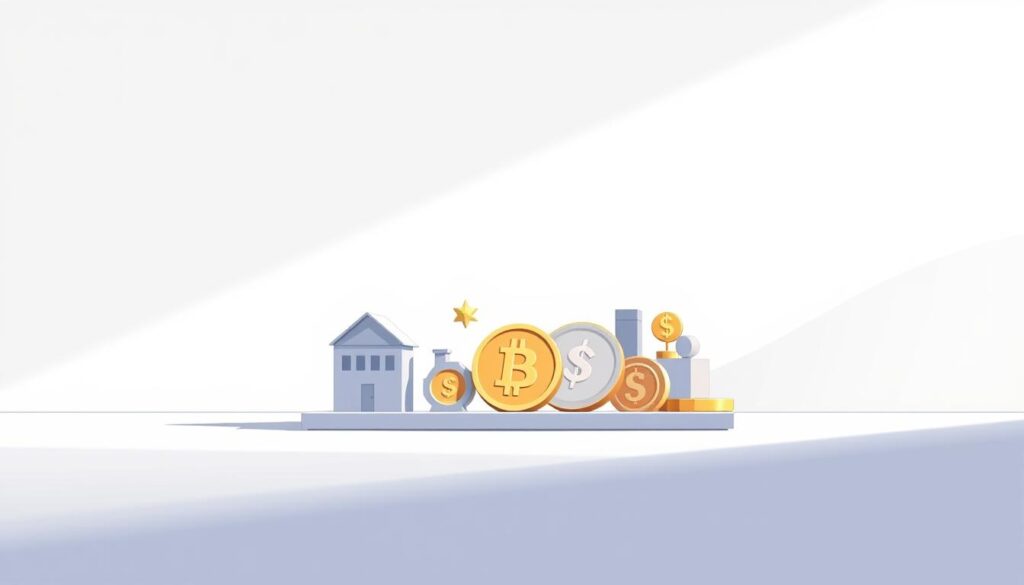For decades, physical property has anchored portfolios as a time-tested wealth preservation tool. Over 35% of Americans consistently ranked it their top choice for growing savings, according to Gallup surveys. Historical data reveals residential and commercial properties delivered 11.51% average annual returns across four decades, outperforming many traditional options.
Now, digital innovations challenge this dominance. Younger investors increasingly favor blockchain-based alternatives, drawn to features like fixed scarcity and decentralized security. Bitcoin’s 21-million supply cap contrasts sharply with land’s finite-but-flexible availability, sparking debates about which model better resists inflationary pressures.
This divide reflects deeper questions about what makes an asset reliable long-term. Stability, liquidity, and universal recognition remain critical factors. Yet evolving technologies and shifting priorities—like portability and transaction speed—reshape expectations. Markets now face a pivotal moment: Can age-old strategies coexist with disruptive new systems?
Key Takeaways
- Physical property remains a top choice for 35% of U.S. investors, per Gallup data
- Average annual returns of 11.51% since 1981 highlight real estate’s historical strength
- Bitcoin’s capped supply creates artificial scarcity similar to prime land
- Blockchain security features reduce fraud risks compared to traditional transactions
- Generational priorities influence preferences for tangible vs. digital holdings
- Inflation concerns drive interest in both asset types as protective measures
Introduction and Investment Context
Economic foundations are being reshaped as digital innovations collide with conventional wealth-building methods. Younger demographics now question systems requiring six-figure commitments and bureaucratic hurdles, while older generations cling to proven physical holdings.
Overview of Traditional vs Digital Assets
Physical holdings like land and buildings have long provided dual benefits: steady rental earnings and value growth over decades. These tangible assets demand significant upfront capital—often requiring credit checks and 20% down payments. Legal processes can stretch across months, with multiple intermediaries taking fees at each stage.
Digital alternatives operate on decentralized networks, enabling instant global transactions. Blockchain systems remove third-party oversight through cryptographic verification. Fractional ownership models let participants start with pocket change rather than life savings.
Generational Priorities Redefine Markets
Pew Research reveals only 16% of Americans engage with digital currencies, compared to 56% holding stocks. This gap narrows sharply among under-35 demographics, where 43% express interest in crypto according to CNBC surveys.
Digital natives prioritize accessibility over tradition. “Why wait years to qualify for mortgages when you can build positions gradually?” argues fintech analyst Mara Linetti. Millennials face average home prices 4.5 times their income—a stark contrast to Baby Boomers’ 1.7 ratio during their prime buying years.
This friction pushes younger crowds toward assets bypassing legacy gatekeepers. While volatility concerns persist, 24/7 trading windows and transparent ledgers align with tech-savvy preferences.
Traditional Asset Insights: Real Estate as a Store of Value

Brick-and-mortar holdings continue to anchor financial strategies through predictable growth patterns. Physical properties deliver consistent performance even during economic turbulence, maintaining their appeal across generations.
Stability and Long-Term Wealth Building
Physical assets exhibit 40% less price swings than equities during recessions, per Federal Reserve data. This resilience stems from dual income potential: monthly rentals and gradual appreciation. Short-term vacation leasing platforms expanded revenue opportunities, with Airbnb hosts averaging $14,000 annual earnings in metro areas.
Investment Trends and Property Market Dynamics
Decades of 11.51% yearly gains demonstrate tangible holdings’ capacity to outpace inflation. Tax benefits like depreciation write-offs and 1031 exchanges enhance net returns. However, median home prices now require 6.7 years of median household income—triple 1980s ratios—creating entry barriers for new participants.
Strategic buyers leverage creative financing, from lease-options to REIT shares. These approaches preserve property’s role in diversified portfolios while addressing modern affordability challenges.
Digital Disruption: Bitcoin and the World of Cryptocurrency
Digital currencies are rewriting financial rulebooks with decentralized networks and algorithmic scarcity. Unlike physical holdings, these systems prioritize borderless access over geographic limitations—a shift resonating with tech-oriented investors.
Blockchain Technology and Security Advantages
Bitcoin’s backbone lies in its unbreakable encryption protocols. Every transaction gets locked into a public ledger verified by thousands of nodes globally. This decentralized validation slashes fraud risks—no single entity can alter records retroactively.
The 21-million supply cap mimics precious metal scarcity but with digital precision. “You can’t mine more Bitcoin than the code allows, making it inflation-resistant by design,” explains blockchain developer Carlos Mendez. This programmed limitation contrasts sharply with traditional currencies subject to central bank policies.
Market Volatility and Liquidity Considerations
While crypto markets never close, their prices swing wildly. Bitcoin lost 65% of its value in 2022 but rebounded 130% within six months. Ethereum’s 2023 rollercoaster—plummeting 40% before doubling—shows both peril and potential.
High liquidity lets investors exit positions instantly, unlike property sales requiring months. Over 500 exchanges now enable conversions to cash or other assets in minutes. Yet rapid shifts demand ironclad risk management strategies many newcomers underestimate.
Real Estate, Cryptocurrency, Store of Value, Investment Comparison

Modern portfolios demand fresh approaches as financial landscapes evolve. Physical holdings and digital alternatives present distinct paths for wealth preservation, each requiring careful evaluation based on individual goals.
Risk vs. Reward: Evaluating Each Asset Class
Physical properties typically show 65% less annual volatility than digital currencies, according to Yale University research. Rental yields average 4-8% annually, providing predictable returns. In contrast, blockchain-based options have delivered 200%+ gains during bull markets—followed by 70%+ corrections.
| Factor | Physical Holdings | Digital Options |
|---|---|---|
| Liquidity | 3-6 month sales cycle | Instant transactions |
| Income Generation | Monthly cash flow | Speculative growth |
| Market Hours | Business days only | 24/7 trading |
| Entry Cost | $50k+ minimum | $10 fractional buys |
Diversification Through Technological Convergence
Blockchain-enabled property tokens now let buyers own 1% stakes in commercial buildings through secure ledgers. This hybrid model combines physical asset stability with crypto’s liquidity. Over $3 billion worth of tokenized properties traded hands in 2023, per Deloitte reports.
“Portfolios blending physical and digital assets outperform single-class strategies by 22% annually,” notes wealth manager Rachel Torrez.
Smart investors balance both worlds. Allocate 60-70% to income-generating physical assets, reserving 10-15% for high-growth digital positions. Regular rebalancing maintains target exposure as markets shift.
Conclusion
Financial strategies face unprecedented evolution as emerging technologies redefine wealth preservation. While physical properties maintain their appeal through predictable cash flow, digital alternatives offer groundbreaking flexibility. Savvy investors now blend both approaches to hedge against market shifts.
Hybrid models like tokenized real estate demonstrate how traditional and modern systems can coexist. These innovations merge brick-and-mortar stability with blockchain’s borderless access, creating new opportunities for portfolio growth. Younger demographics drive adoption, while experienced players appreciate enhanced liquidity.
Success lies in understanding each asset’s role. Physical holdings anchor portfolios against volatility, while crypto provides exposure to exponential growth sectors. Regular reassessment ensures alignment with personal goals and risk tolerance.
The future belongs to those embracing change without abandoning proven strategies. Stay informed, remain adaptable, and let data guide decisions in this dynamic landscape. True wealth preservation now requires mastering both tangible and digital realms.
FAQ
Why do younger investors lean toward digital currencies over physical assets?
Younger generations often prioritize accessibility, speed, and technological innovation. Digital currencies like Bitcoin offer 24/7 trading, lower entry costs, and alignment with tech-driven financial trends compared to traditional options like property.
How does property ownership protect against economic instability?
Physical assets like land or buildings historically retain worth during inflation. Their tangible nature provides predictable cash flow through rentals, while scarcity in prime locations supports long-term appreciation.
What makes blockchain-based transactions more secure?
Blockchain’s decentralized ledger system ensures transparency and immutability. Each transaction is encrypted and verified across multiple nodes, reducing fraud risks and eliminating intermediaries like banks.
Can high volatility in digital markets impact long-term growth?
Yes, rapid price swings can create short-term uncertainty. However, assets like Bitcoin have shown resilience over extended periods, often outperforming traditional markets when viewed through a multi-year lens.
Is diversifying across both asset classes a viable strategy?
Absolutely. Combining physical holdings with digital tokens balances stability and growth potential. For example, rental income offsets crypto’s fluctuations, while blockchain gains amplify portfolio returns.
How does inflation affect these investment options differently?
Tangible properties often rise with inflation due to construction costs and demand. Some digital assets, like Bitcoin, have fixed supplies, acting as deflationary hedges when fiat currencies lose purchasing power.
What role does liquidity play in choosing between these assets?
Digital tokens can be traded instantly on global exchanges, offering flexibility. Physical holdings require longer processes for sales or refinancing, making them less ideal for urgent cash needs.


